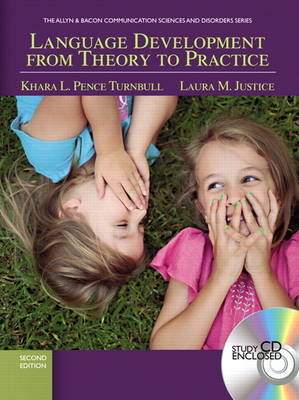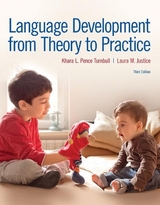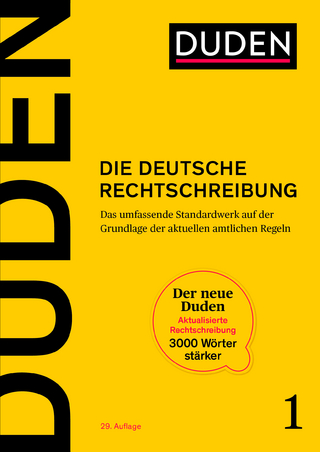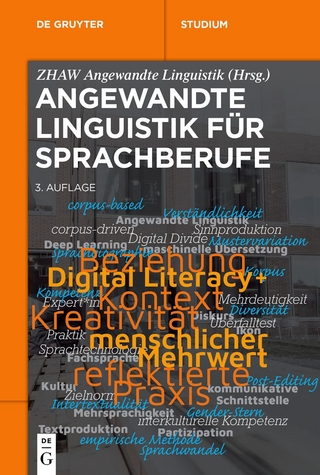
Language Development From Theory to Practice
Pearson (Verlag)
978-0-13-707347-4 (ISBN)
- Titel erscheint in neuer Auflage
- Artikel merken
Language Development from Theory to Practice provides students with a user-friendly approach to key topics in language development, including research methods, theoretical perspectives, major language milestones from birth to adolescence, and language diversity and language disorders. The research based and theoretical foundation found in this engaging text is designed to prepare students for advanced study in subjects associated with language development by summarizing the various theoretical orientations that have guided research and practice. With an emphasis on the relevance of the material to students’ current and future experiences in clinical, educational, and research settings, this text also focuses on individual differences in language development, including those of children who are developing language in diverse cultures or who are developing language atypically.
Features
· A balance of theory and practice provides students with a theoretical and scientific foundation to the study of language development and prepares them for advanced study in language development and related fields.
· A multidisciplinary focus allows readers to best understand the constantly evolving and diverse world of language development study
· Multicultural considerations in understanding language development promotes students’ awareness of the way culture interacts with language development for children from diverse backgrounds within and beyond North American communities.
· An emphasis on research familiarize students with the use of evidence-based practices as well as the most current empirical findings in children’s language achievements.
· A reader-friendly format and style promotes student learning with boldfaced terms, helpful figures and graphs, discussion questions, and an engaging writing style.
· Learning tools and features, include focus questions, chapter summaries, resource lists, boxed inserts.
· A companion website located at www.pearsonhighered.com/pence2e, offers students reflection questions, study items, and helpful website links to related sites of interest for further study.
· A CD-ROM that contains language samples of children from birth through 13 years of age and video clips of research paradigms used to learn about language development gives students an opportunity to hear and visualize language development and language development concepts.
Glossary
Brief Contents
Chapter 1 Language Development: An Introduction
Chapter 2The Science and Theory of Language Development
Chapter 3Building Blocks of Language
Chapter 4 Neuroanatomy and Neurophysiology of Language
Chapter 5Infancy: Let the Language Achievements Begin
Chapter 6Toddlerhood: Exploring the World and Experimenting with Language
Chapter 7Preschool: Building Literacy on Language
Chapter 8 School-Age Years and Beyond: Developing Later Language
Chapter 9 Language Differences and Disorders
Glossary
References
Subject and Name index
Contents
1 Language Development: An Introduction
Focus Questions
Important Terms
What Is Language?
Language Defined
Language as a Module of Human Cognition
How Does Language Relate to Speech, Hearing, and Communication?
Speech
Hearing
Communication
What Are the Major Domains of Language?
Form, Content, and Use
Components of Form, Content, and Use
What Are Some Remarkable Features of Language?
Acquisition Rate
Universality
Species Specificity
Semanticity
Productivity
What Are Language Differences and Language Disorders?
Language Differences
Language Disorders
Summary
2 The Science and Theory of Language Development
Focus Questions
Important Terms
Who Studies Language Development and Why?
Basic Research
Applied Research
What Are Some Major Approaches to Studying Language Development?
Approaches to Studying Speech Perception
Approaches to Studying Language Production
Approaches to Studying Language Comprehension
What Are Some Major Language Development Theories?
Questions That Should Be Answered by Language Theories
Major Language Development Theories
How Do Language Development Theories Influence Practice?
Linkage of Theory to Practice
Instruction in English as a Second Language: Theory and Practice
Practices Informed by Language Theories
Evidence-Based Practice: Linking Theory, Science, and Practice
Summary
3 Building Blocks of Language
Focus Questions
Important Terms
What Is Phonological Development?
Phonological Building Blocks
Influences on Phonological Development
What Is Morphological Development?
Morphological Building Blocks
Influences on Morphological Development
What Is Syntactic Development?
Syntactic Building Blocks
Influences on Syntactic Development
Influences on Syntactic Development
What Is Semantic Development?
Semantic Building Blocks
Influences on Semantic Development
What Is Pragmatic Development?
Pragmatic Building Blocks
Influences on Pragmatic Development
Summary
4 Neuroanatomy and Neurophysiology of Language
Focus Questions
Important Terms
What Are Neuroanatomy and Neurophysiology?
Terminology
Neuroscience Basics
What Are The Major Structures And Functions Of The Human Brain?
Cerebrum
Brainstem
Cerebellum
How Does the Human Brain Process and Produce Language?
Semantics
Syntax and Morphology
Phonology
Pragmatics
What Are Neurophysiological and Neuroanatomical Sensitive Periods?
Sensitive Periods Defined
Neuroanatomical and Neurophysiological Concepts Related to Sensitive Periods
Sensitive Periods and Language Acquisition
Summary
5 Infancy: Let the Language Achievements Begin
Focus Questions
Important Terms
What Major Language Development Milestones Occur in Infancy?
Infant Speech Perception
Awareness of Actions and Intentions
Category Formation
Early Vocalizations
Additional Milestones
What Are Some of the Early Foundations for Language Development?
Infant-Directed Speech
Joint Reference and Attention
Daily Routines of Infancy
Caregiver Responsiveness
What Major Achievements in Language Form, Content, and Use Characterize Infancy?
Language Form
Language Content
Language Use
What Factors Influence Infants’ Individual Achievements in Language?
Intraindividual Differences
Interindividual Differences
How Do Researchers and Clinicians Measure Language Development in Infancy?
Researchers
Clinicians
Summary
6 Toddlerhood: Exploring the World and Experimenting with Language
Focus Questions
Important Terms
What Major Language Development Milestones Occur in Toddlerhood?
First Words
Gestures
What Major Achievements in Language Form, CONTENT, and Use Characterize Toddlerhood?
Language Form
Language Content
Language Use
What Factors Influence Toddlers’ Individual Achievements in Language?
Intraindividual Differences
Interindividual Differences
How Do Resesarchers and Clinicians Measure Language Development in Toddlerhood?
Researchers
Clinicians
Summary
7 Preschool: Building Literacy on Language
Focus Questions
Important Terms
What Major Language Development Milestones Occur in the Preschool Period?
Decontextualized Language
Emergent Literacy
What Major Achievements in Language Content, Form, and Use Characterize the Preschool Period?
Language Form
Language Content
Language Use
What Factors Influence Preschoolers’ Individual Achievements in Language?
Intraindividual Differences
Interindividual Differences
How Do Researchers and Clinicians Measure Language Development in the Preschool Period?
Researchers
Clinicians
Summary
8 School-Age Years and Beyond: Developing Later Language
Focus Questions
Important Terms
What Major Language Development Milestones Occur in the School-Age Years and Beyond?
Shifting Sources of Language Input
Acquisition of Metalinguistic Competence
What Major Achievements in Language Content, Form, and Use Characterize the School-Age Years and Beyond?
Language Form
Language Content
Language Use
What Factors Influence School-Age Children’s, Adolescents’, and Adults’ Individual Competencies in Language?
Language and Gender
Language and Aging
How Do Researchers and Clinicians Measure Language Development in the School-Age Years and Beyond?
Assessment Types
Assessment of Language Form
Assessment of Language Content
Assessment of Language Use
Summary
9 Language Diffrences and Disorders
Focus Questions
important terms
WHAT ARE DIALECTSWhat are?
Dialects
Pidgins
Creoles
What Are Bilingualism and Second Language Acquisition?
Bilingualism and Multilingualism
Second Language Acquisition
What Is a Language Disorder?
Distinguishing Between Language Disorders and Language Differences
Prevalence
What Are The Major Types of Child Language Disorders?
Specific Language Impairment
Autism Spectrum Disorder
Intellectual Disability
Traumatic Brain Injury
Hearing Loss
Identification and Treatment of Language Disorders
Summary
References
Subject and name Index
| Erscheint lt. Verlag | 28.2.2011 |
|---|---|
| Sprache | englisch |
| Maße | 185 x 231 mm |
| Gewicht | 726 g |
| Themenwelt | Geisteswissenschaften ► Sprach- / Literaturwissenschaft ► Sprachwissenschaft |
| Medizin / Pharmazie ► Gesundheitsfachberufe ► Logopädie | |
| ISBN-10 | 0-13-707347-X / 013707347X |
| ISBN-13 | 978-0-13-707347-4 / 9780137073474 |
| Zustand | Neuware |
| Haben Sie eine Frage zum Produkt? |
aus dem Bereich



